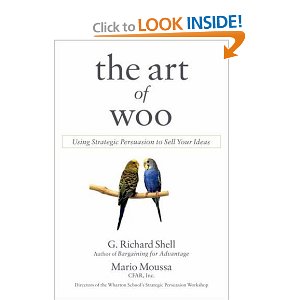Book Recommendation: The Art of Woo
 Last week I wrote an article about persuasion as a process, in which I emphasized the critical importance of preparation and positioning before you get in front of your intended audience. I’ve chosen The Art of Woo for this week’s book recommendation for the lessons it includes about strategic persuasion.
Last week I wrote an article about persuasion as a process, in which I emphasized the critical importance of preparation and positioning before you get in front of your intended audience. I’ve chosen The Art of Woo for this week’s book recommendation for the lessons it includes about strategic persuasion.
I have to say first that I don’t care for the title. Woo is an awkward acronym for “winning others over”, and the use of the word art weakens their main point that persuaders can follow systematic processes to analyze their situation, craft an appropriate persuasive approach, and secure their commitments. (Based on my experience with my own book, I bet it wasn’t their first choice.)
The book is divided into four sections that correspond to their 4-step process:
1. Survey the situation
2. Confront the five barriers to selling your ideas
3. Make your pitch
4. Secure your commitments
Survey the situation: The theme of the first chapter in this section is that you must start with yourself first; by understanding your own persuasive style you can see how others see you and make adjustments as necessary. This is useful foundational information, similar to social style selling, but once you learn it you should focus less on yourself and more on the preferred styles of those you want to persuade. The next chapter is very important, and in my opinion could have been even longer. It is about coming up with solid ideas and polishing them with relentless research; understanding and navigating the decision-making system in your organization, and implementing a strategy to sell the idea.
Confront the five barriers: There are many ways a persuasion campaign can go off track. The next three chapters describe these barriers and what to do about them: poor relationships, damaged credibility, communication mismatches, your audience’s belief systems, and their interests and needs. The most important insight in this section is the critical importance of character and integrity in persuasion. There are books full of tricks and shortcuts to influence others’ choices, but in the long run these damage credibility, impair relationships, and detract from the real work of carefully aligning your proposal with the needs and belief systems of those who must approve it.
Make your pitch: This section is solid, although it doesn’t break any new ground in terms of how to actually structure your presentation and choose the appropriate evidence. Chapter 7 introduces a simple yet effective model called PCAN: Problem, Cause, Answer, and Net benefits. The statement of the problem is the most important part, because it answers the “So What?” question for the audience; additionally, how you frame the problem is going to go a long way to determine the audience’s response and the range of acceptable solutions. The authors could have focused a little more on the cost of the problem to increase the urgency, but on the whole it’s well done. Chapter 8 discusses ways to make your proposal more memorable. If you don’t have time to read Made to Stick, you’ll find this chapter useful.
Secure your commitments: The final two chapters discuss the politics of making sure you get people actually follow through on the commitments that you get from following the first three steps—much easier said than done! Even if you do everything right, you still have to overcome corporate inertia and politics. These chapters give a good overview; if you want more, you can pick up one of Kotter’s books n change management or Jeffrey Pfeffer’s books on power.
Re-reading what I’ve written so far about this book, it may seem a bit critical for a book that I strongly recommend. This is mainly because this ambitious book covers a lot of ground, so it has to be a little more superficial than I would like. But, as a survey it works very well, and their points are clearly illustrated with a profusion of historical examples from politics and business. The authors are clearly well-read and range far beyond the staples of the past few years’ worth of business stories. If you only choose one book to read on presenting your ideas, it’s hard to go wrong with The Art of Woo.


